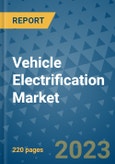The vehicle electrification market is experiencing significant growth driven by the desire to reduce dependence on polluting fossil fuels and incentives to promote electric mobility. As the commercialization of electric vehicles (EVs) progresses, it is reshaping the automotive industry and prompting automakers to recognize that electric vehicles are the future of personal mobility. Increasing concerns about climate change and air pollution are putting pressure on carmakers to develop sustainable transportation solutions. As a result, fossil fuel-powered vehicles are facing stiff competition from EVs, with developed countries improving infrastructure and implementing favorable policies to boost demand in the vehicle electrification market.
Traditional Carmakers Shift Focus to Meet Stringent Emission Standards
The transportation sector is a major consumer of energy, with the majority coming from gasoline. It also contributes significantly to greenhouse gas (GHG) emissions, largely driven by internal combustion engine (ICE) vehicles. In response, governments have invested heavily in vehicle electrification to reduce emissions and dependence on crude oil, thereby stabilizing oil prices. Major companies such as BMW, Tesla, Nissan, and GM have announced their plans for vehicle electrification, and others are expected to follow suit. For example, the VW group has committed to offering 70 electric vehicles within the next five years, while Ford Motor Co. is significantly increasing its investment in vehicle electrification.Vertical Integration and Joint Ventures Drive Success in the Vehicle Electrification Market
The vehicle electrification market is characterized by fragmentation, leading global automakers to form strategic alliances. Vertical integration is a key strategy for carmakers to differentiate themselves from the competition. Companies like VW and Ford are collaborating on the development of autonomous EVs, while LG and GM have formed partnerships to share costs in emerging technologies. Other companies in the vehicle electrification market include Nissan, Skoda, GM, BMW, Daimler, Denso, BorgWarner, Mitsubishi Electric, Volvo, Lucid, Tesla, ZF, Valeo, and Robert Bosch.Investment in Public Infrastructure Shifts Focus from ICE Vehicles to EVs
Significant infrastructural shifts in China, Europe, and the US have played a crucial role in the growth of the vehicle electrification market. EV demand has consistently grown at a double-digit rate in both the US and Europe in recent years. Despite the COVID-19 pandemic impacting overall vehicle sales, EVs have outperformed the market in countries like Germany, driving growth in the vehicle electrification sector. Commercial vehicle electrification is also evolving, particularly in public logistics and transportation, which are vital in urban areas. The need for public infrastructure is particularly strong in Europe, ASEAN, and Australia, as existing infrastructure may not be able to meet future demand. This presents significant opportunities for OEMs in the vehicle electrification market to expand into new geographies and product categories.Table of Contents
1. Executive Summary
2. Market Overview
3. Global Vehicle Electrification Market Outlook, 2019 - 2030
4. North America Vehicle Electrification Market Outlook, 2019 - 2030
5. Europe Vehicle Electrification Market Outlook, 2019 - 2030
6. Asia Pacific Vehicle Electrification Market Outlook, 2019 - 2030
7. Latin America Vehicle Electrification Market Outlook, 2019 - 2030
8. Middle East & Africa Vehicle Electrification Market Outlook, 2019 - 2030
9. Competitive Landscape
10. Appendix
Companies Mentioned
- Bosch
- Continental AG
- Denso Corporation
- BorgWarner Inc.
- Hitachi Ltd.
- Mitsubishi Electric Corporation
- JTEKT Corporation
- Magna International
- Valeo SA
- Mahle GmbH
- Marelli Corporation
- ZF Friedrichshafen AG
- Eaton Corporation
Methodology

LOADING...








